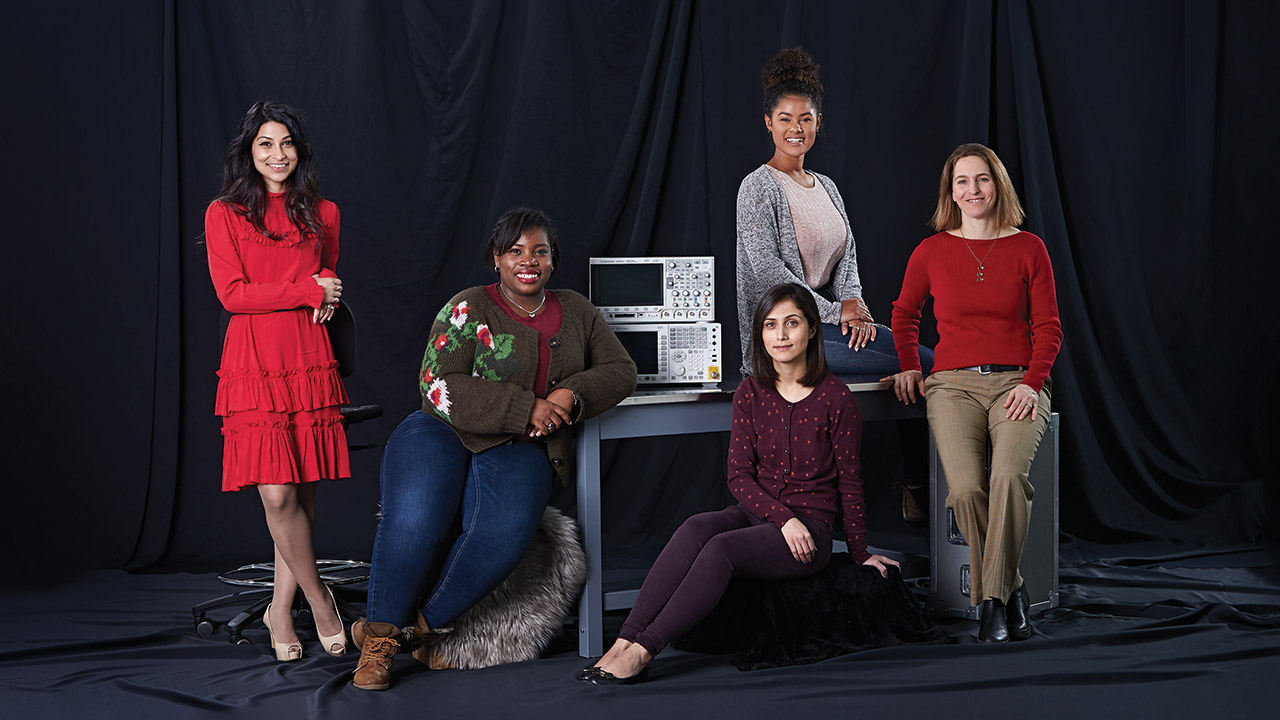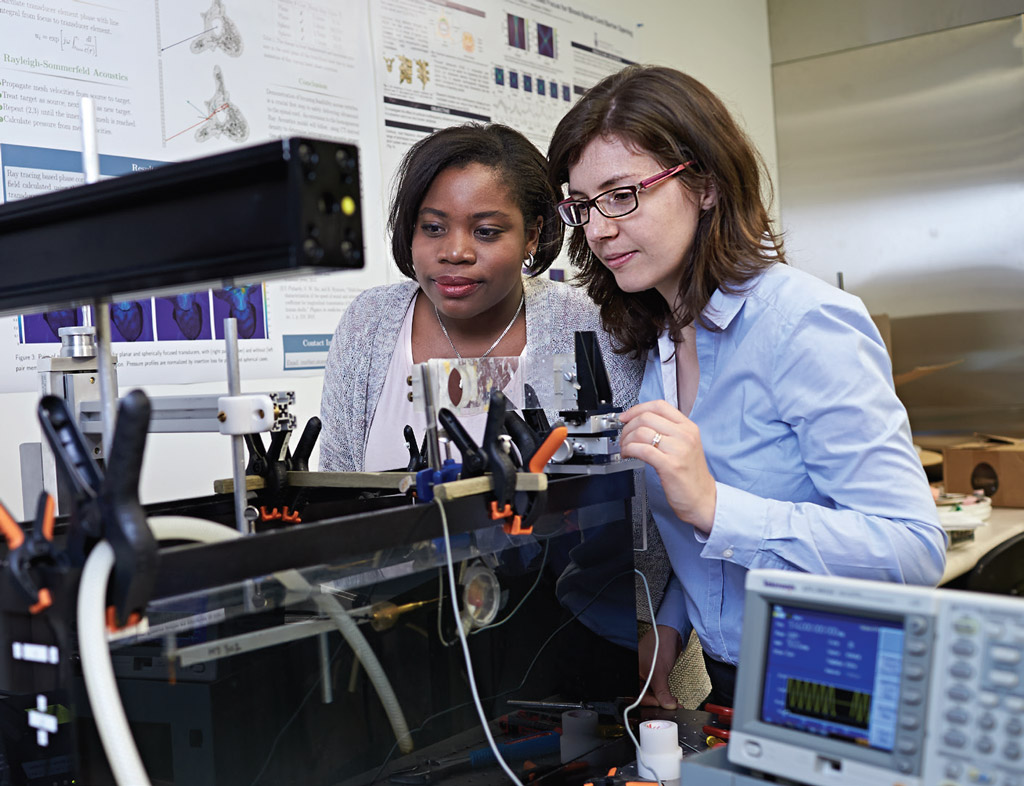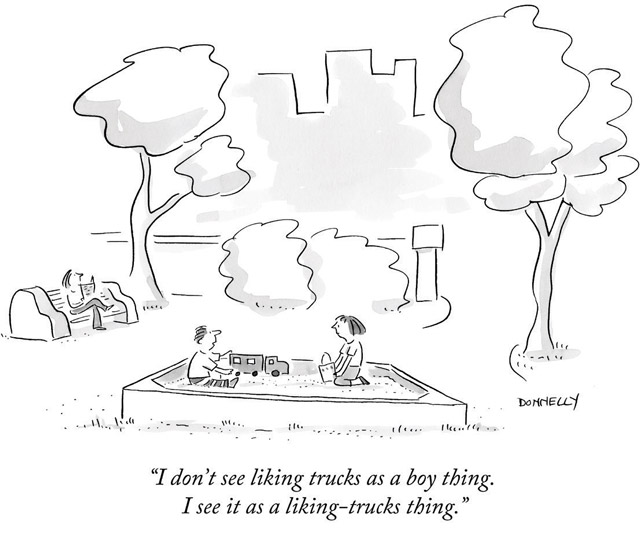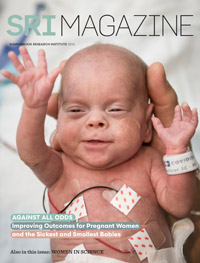Let's talk (women in science)

What will it take to boost participation of women in engineering and physics, where gender imbalance is notably prominent? Contributing to the conversation, for starters
September 12, 2018

From left to right: Dr. Trisha Roy, Stecia-Marie Fletcher, Hanieh Arjmand, Paige Smith and Dr. Cari Whyne.
Photo: Nation Wong
“Life need not be easy, provided only that it is not empty.”
—Lise Meitner, physicist who discovered nuclear fission
In a photo Dr. Trisha Roy posted to Twitter, she stands above bloody gauze and surgical scissors. She has donned a face mask, cap, gown and gloves, and it’s clear from her caption that she’s training to become a vascular surgeon. Her caption also indicates she’s adding to a discussion around women in science. Shared Aug. 10, 2015, Roy’s post includes the hashtags #ILookLikeAnEngineer and #ILookLikeASurgeon.
Days before Roy’s tweet, female engineer Isis Wenger launched a social media campaign using the hashtag #ILookLikeAnEngineer after an ad she was featured in ignited a fiery reaction. Several people were outraged, claiming Wenger was “too attractive” to be a “real” engineer. In response, Wenger encouraged engineers to share photos of themselves with the hashtag #ILookLikeAnEngineer to debunk myths about how engineers are “supposed” to look. A debate had begun to blaze on the role of gender stereotypes in engineering, and Roy was lending her voice to the dialogue. In her view, awareness is the first step to deconstruct this complex issue.
Gender equality and diversity remain issues in contemporary workplaces, affirmed by a substantial body of research, said keynote speaker Dr. Curt Rice at the 2017 International Conference on Medical Image Computing and Computer Assisted Intervention (MICCAI). “What’s clear at this point is that there is a considerable literature making the strong case that women and men are treated differently in the workplace,” he said to the crowd of engineers, physicists and others involved in biomedical imaging. Rice, who is the president of the Oslo and Akershus University College of Applied Sciences, and who leads Norway’s Committee for Gender Balance and Diversity in Research, noted that addressing imbalances benefits everyone, but to do this, “We have to reconceive the whole system.”
Reforming the system includes tackling low numbers of women in science. According to a 2017 Engineers Canada report, data from 2016 show that 12.8% of practising professional engineers and 17% of newly licensed engineers are women. The gender imbalance doesn’t exist only in the workforce. Canadian census numbers from 2017 show that about 25% of women with doctorate degrees went into architecture, engineering and related technologies. Of people with bachelor degrees or higher, five times as many men as women elected to go into science, technology, engineering and math (STEM). Engineers Canada reports that women made up 20% of those enrolled in Canadian undergraduate engineering programs, which aligns with U.S. numbers. A 2016 news article in Nature states that although 49% to 58% of U.S. undergraduates and graduates in the social and life sciences are women, that number plummets to about 20% in physics, a gap that has stubbornly persisted.
Other research has emerged. A 2018 PLOS Biology study by Dr. Luke Holman and colleagues looked at how long it would take women to catch up to their male counterparts in science publishing. The team examined the number of male and female authors on more than 10 million academic papers published over the last 15 years, and found that, overall, it would take 16 years before parity is reached. In physics, it would take roughly 258 years for the gap to close if nothing is done. The study also shows that the rate of published female authors in physics—slightly more than 15%—is among the lowest of all fields. Women in biomedical engineering and diagnostic imaging fare better, but still hover around the bottom, at roughly 25% and 30%, respectively.
Although the ratio of men to women in engineering and physics is better today than it was years ago, it remains uneven. Stecia-Marie Fletcher, a PhD student at Sunnybrook Research Institute (SRI), says she was one of two women out of 100 students in a master’s level class while pursuing her undergraduate degree in the U.K. Fletcher, who is helping to investigate the use of focused ultrasound to open the blood-spinal cord barrier to deliver treatments, was born in Trinidad and Tobago. Being a visible minority and a woman is what she laughingly calls “a double whammy.” She says, “Usually, if I’m not the only woman in the room, I am the only black person in the room.” Indeed, there’s evidence to show that women of colour in science face unique barriers. Of the 60 female scientists of colour interviewed for a 2016 study led by Joan Williams published in the Journal of Research in Gender Studies, 100% reported encountering gender bias.
Fletcher’s supervisor is Dr. Meaghan O’Reilly, a scientist in Physical Sciences at SRI and an assistant professor in the department of medical biophysics at the University of Toronto. O’Reilly says she notices how few women there are when she attends conferences. “At a conference, you might see a two to one ratio [of men to women], or it’s even more skewed,” she says. O’Reilly is pioneering new research into focused ultrasound. She recently helmed a study published in Scientific Reports that is the first to show that using focused ultrasound to deliver a drug to treat tumours in the spinal cord has a therapeutic effect.
Hanieh Arjmand also identifies conferences as sites of unequal gender representation. A PhD student at SRI who models the craniofacial skeleton to optimize fracture fixation techniques following traumatic injuries, Arjmand completed her undergraduate degree in Iran. She immigrated to Canada five years ago to continue her studies. “You go to conferences, and the first thing that strikes me at the registration table is that it’s mostly females, and then the people introducing speakers and doing the planning, they’re mostly males.”
O’Reilly’s and Arjmand’s observations about gender imbalance at conferences has support. A 2018 Nature Communications article by Dr. Heather Ford and colleagues shows that fewer women are invited to submit abstracts than men. Looking at career stage, mid-career and experienced women are least likely to receive invitations. The same paper also demonstrates that women choose poster-only presentations more than men, which the authors attribute to lack of confidence and women’s tendency to underestimate their ability and performance in science.

Dr. Trisha Roy, who followed in her father’s footsteps by becoming an engineer, divides her time between research at Sunnybrook Research Institute and surgery at Sunnybrook.
Photo: Kevin Van Paassen
Although low numbers of women in physics and engineering continue to plague the fields, clearly some women do choose—and thrive in—these areas. This could be a result of not having experienced severe forms of sexism, or having support to manage family matters that disproportionately affect women. It could also mean early exposure to math and science.
“I was really good at math growing up, really good at physics,” Fletcher says. She adds that she was teased for this, as the subjects weren’t “traditionally” what girls gravitated toward. Dr. Anne Martel, a senior scientist in Physical Sciences at SRI and a professor in the department of medical biophysics at U of T, as well as a MICCAI board member, also warmed to science at an early age. “I liked the fact that it wasn’t subjective,” she says. She has since become a significant contributor to the field of medical imaging, recently publishing a paper in Radiology showing how extracting features from images and feeding them into computer algorithms can help radiologists identify benign versus cancerous lesions.
O’Reilly muses that having four brothers encouraged her access to non-gender-stereotypical activities and pastimes. “I ended up doing a lot of things that my brothers did. I think in that sense I was always comfortable in some of the ‘non-traditional’ fields for girls,” she says. “My sister and I were both hockey players at a time when it was not really that common for girls to play hockey. I was on the chess team—I never understood why there weren’t more girls on the chess team in elementary school; it doesn’t seem like it should be a gender-specific thing, but for some reason it was. I was on the robotics team, and again, my sister and I were the only two girls in our high school on the robotics team.” She says stereotypes were not imposed on her as a child, and that this granted her freedom to explore her interests in math and science.
Arjmand’s enthusiasm for math was cultivated by her father, a civil engineer. She says he would ask her to answer math equations when she was a child. Eventually, even after she had finished classes for the day, she’d ask her father to teach her material she hadn’t learned in school. “I really loved that. It was fun,” she recalls. There’s a clear parallel between Arjmand’s upbringing and Roy’s introduction to engineering. Roy, a vascular surgery resident who successfully defended her PhD in November 2017 and splits her time between research at SRI and surgery at Sunnybrook, says, “My dad is a mechanical engineer, so he really inspired me to become an engineer, too.” She adds that the same bug bit her older brother—he’s a nuclear engineer.
Co-supervised for her doctorate by surgeon-scientist Dr. Andrew Dueck and senior scientist Dr. Graham Wright at SRI, Roy developed a new MRI method for use in surgery to restore blood flow to the legs of people with peripheral arterial disease. The tool can identify of what lesions are made, which helps doctors determine treatment routes. The guiding aim is to prevent limb amputation in this population.
For women who do enter into engineering and physics, deep-seated stereotypes can manifest in bias. A 2016 paper by Dr. Sarah Banchefsky and colleagues in Sex Roles outlined a study that presented photos of male and female STEM faculty to people who were unaware of the subjects’ occupations. The participants were asked to rate the photos on femininity and likelihood of being a scientist or teacher. Results indicate that the more stereotypically feminine a woman appeared, the less likely she was to be deemed a scientist and the more likely she was deemed to be a teacher. Perceived femininity had no bearing on the judgment of male scientists.
“The ways in which we currently treat men and women differently are not about maliciousness. They’re for the most part not about explicit sexism. They are about implicit bias, and that concept deserves your attention,” Rice said. He stressed the importance of acknowledging the effect this bias has on the careers of women.
Indeed, for the most part, it’s not about egregious sexism; rather, it’s about subtle, even unintentional, bias, which itself is problematic. When Roy considers her career path, she relives an experience in which she confronted a sexist response from a male peer. During her studies at U of T, she was ranked first in her class. Disappointed his name wasn’t at the top of the list, the classmate who ranked second incredulously remarked, ‘You? Smart?!’ It was a condescending reaction she met with astonishment and laughter.

Hanieh Arjmand, a PhD student at Sunnybrook Research Institute, cites conferences as areas with glaring gender imbalances.
Photo: Nation Wong
A chuckle is also Roy’s response when she thinks back to receiving an email in December 2017. Designed to notify recipients of a symposium, it was addressed to “Mr. Roy.” “I get that often! [laughs] Every time I’m shocked, and I don’t know why I’m still shocked,” Roy says. “It’s just ridiculous. It makes my heart sink a little.” She tweeted a screenshot of the email, noting: “Most of the engineering-related e-mails I receive are addressed to “Mr. Roy”. This is what happens when < 13% of engineers in Canada are women. We can do better!” Citing Isis Wenger’s social media campaign, Roy included the hashtags #ILookLikeAnEngineer and #ILookLikeASurgeon.
Martel recalls an example of subtle bias that she encountered concerning a reference letter written for her. Although positive traits were highlighted, nothing was mentioned of her scientific capabilities, totally unintentionally, she underscores. This, it turns out, is fairly common. Published in Nature Geoscience in 2016, a study led by Dr. Kuheli Dutt that looked at more than 1,200 recommendation letters showed that female applicants were only one-half as likely as males to receive excellent letters. Further, there was no difference between men and women writers—both crafted stronger letters for males.
Like Martel, Dr. Cari Whyne, a senior scientist in Physical Sciences and director of the Holland Bone and Joint Research Program at SRI, and Arjmand’s supervisor, hasn’t had to deal with overtly inappropriate behaviour. She revisits what she calls a “small” brush with sexism that occurred several years ago when she received a forwarded email from someone outside the institute. Since she hadn’t read the previous messages, she scrolled to the bottom and found statements about her made by a male employee of the company. “We were supposed to be working professionally, and he was commenting on my appearance. It was a physical description of me, and it was very inappropriate for the workplace,” she says.
The professor in the department of surgery at U of T, whose research is in the area of orthopaedic bioengineering, notes that she didn’t let the incident affect her. Whyne recently published a paper in the Journal of Biomechanics that investigates load transmission through different pelvic shapes and the implications this might bear on fixation in trauma patients, but the biggest focus of her work is on spinal metastases, or cancer that has spread to the spine. Her research explores how practitioners can better assess the likelihood of fracture in patients with tumours of the spine and develop minimally invasive devices to improve treatment.
Having her appearance be the subject of a remark is an experience to which Arjmand can relate. She says after delivering a talk at a conference, a male peer approached her. Instead of talking about the content of her presentation, he commented on her lipstick. “It was very inappropriate. I know he didn’t mean it as an insult, but it embarrassed me,” she says. Arjmand adds that unconscious or unnoticed sexist comments are still problematic, stressing that both men and women can be guilty of making them, and that it’s everyone’s responsibility to be aware of and speak up about sexist behaviour. This point resonates with Fletcher. “I think we need to start talking about it more. It’s good that we talk about it in the global sense, but I think in science we should start our own conversations about it, especially in a field where women are such a minority and probably feel that they can’t speak up for themselves,” she says.
Speaking up is the topic of a 2016 Nature column written by Dr. Tricia Serio, dean of the College of Natural Sciences at the University of Massachusetts in Amherst. “To improve the climate for women in science, it’s time to share our stories of microaggression,” she urges, using a term meant to speak to the everyday slights against any marginalized group, though originally it was specific to such behaviour directed against African-American people. Serio discusses her own experiences, and compels those who have received comments they perceived as sexist, as well as those who realize they have made comments that could be perceived as sexist, to submit their stories to her website, www.speakyourstory.net. Participants can write anonymously what was said to them and how they interpreted the comment. The purpose is not to identify anyone, but rather to make the unconscious, conscious and eventually to eradicate such behaviour.
Subtle sexism aside, a big challenge faced by women in engineering and physics, and some men, is impostor syndrome, Whyne says. The term refers to the belief of a person—often a woman—that she is an impostor among those in her ranks, that her success is a product of luck rather than intelligence and hard work. Despite her achievements, she feels like a fraud at risk of having her cover blown.
Martel substantiates Whyne’s assertion on this, linking impostor syndrome in women to lack of confidence. Having recognized impostor syndrome in herself, she says, “Women are much more circumspect about what they’ll claim, and tend to underestimate or undersell themselves.”
Martel’s argument rings true when considering Fletcher’s comments about impostor syndrome. “I always think, ‘I can’t possibly do this.’ I doubt all of my results. I always feel as if I’m not good enough to do this or to be here,” Fletcher says. Roy’s sentiments differ little. “I always thought even when I did well in engineering, I was very clear that I’m just a book engineer. I know how to do tests. I’m not a real engineer,” she says. “Impostor syndrome is a huge issue for me to this day. It’s very pervasive,” says the woman who received a three-year $150,000 Vanier Canada Graduate Scholarship in 2016.
When Arjmand considers the role impostor syndrome plays in her life, magnified, she says, by coming from a male-dominated mechanical engineering background, she mentions an article she read noting women generally apply for jobs only when they’ve satisfied all requirements, whereas men might apply even if they’ve only met one or two requirements. Rice talked about this at the MICCAI conference, pointing to relevant studies, and adding that higher qualified women choose not to apply for positions because they don’t expect to get them.
Taking impostor syndrome one step further is Paige Smith, who is a master’s student in O’Reilly’s lab. She is contributing to the blood-spinal cord barrier research by developing a controller to ensure the delivery of ultrasound is safe and can be tailored for various treatments. Smith says due to restrictions, some of which are self-imposed, women tend to feel unworthy in their roles and thus fail to negotiate or advocate for themselves. “We’re not supposed to fight for what we think we deserve, just take what we get and sit down because we should be happy that we got the position at all,” she says. Martel builds on this: “If you’re already [asking yourself ], ‘How did I get to where I am?,’ you’re not going to be stirring the pot by going and asking for more money.”
Rice also asserted that institutions are underperforming if they’re not working to fix the system. He was referring specifically to a system that unfairly evaluates women with children, and discussed as evidence a 2007 foundational study by Shelley Correll and colleagues in the American Journal of Sociology. The authors found that based only on a paper file, mothers—or women thought to be mothers—were judged as significantly less competent and committed than women without children; they were held to harsher performance and punctuality standards; when they were hired, their salaries were lower than non-mothers; and they were considered less well-suited for promotions. “Biology matters. Motherhood matters. In fact, even the perception of motherhood matters,” Rice said. More recent studies have shed further light, showing that women in STEM with children are paid less and have less opportunity to engage with mentoring or to benefit from formal or informal networks within the institution and at conferences.

Dr. Meaghan O’Reilly (right) and her PhD student Stecia-Marie Fletcher explore how focused ultrasound can be used to open the blood-spinal cord barrier to deliver therapeutics.
Photo: Nation Wong
Addressing all of this won’t happen overnight, but helping mothers receive equal treatment at work could entail something as simple as instilling a rule that prevents meetings from interfering with child care responsibilities, Martel suggests. “If you’re having to do daycare drop-off and pickup, it’s discriminatory to have a meeting that you can’t attend,” she says. “Avoiding meetings after 5 p.m. also benefits fathers who have young children. Many policies that are initially aimed at reducing bias often have the effect of benefiting both men and women,” adds Martel.
Seeing first-hand women who’ve managed careers as scientists while juggling motherhood is an experience the younger generation values. Speaking about O’Reilly, who delivered a baby girl in the summer of 2017, Smith champions her “inspirational” ability to handle her duties as mother and supervisor, an acclamation Fletcher reiterates: “It’s something I admire her a lot for, and something I think about because one day I want to have a family.” Similar praise is sung for Whyne. Arjmand, who shares that she really wants kids but doesn’t want to “sacrifice” her career, says, “She’s my role model. She’s one of the very few people I know who has the perfect balance between life, having kids, managing a lab and managing students. I’m very happy to be working with her.”
Having mentors is a concept that was emphasized by Dr. Cristina Amon, dean of U of T engineering, at the 2017 Women in Science and Engineering Conference: “As scientists and engineers, we are global citizens and collaborators. But let’s not forget that we are also role models, and it is up to each one of us to set an example and to enable young women and girls to imagine themselves as scientists and engineers with the potential to change the world.” It’s interesting, although perhaps unsurprising, that a study by Drs. Tara Dennehy and Nilanjana Dasgupta published in 2017 in Proceedings of the National Academy of Sciences noted that the existence of female peer mentors in college had a positive impact on women’s academic experiences and led to greater retention in engineering.
Nonetheless, the lack of female representation, and therefore role models, in senior academic positions is startling. In Canada 5.6% of full professors in physics, and 11.1% of full professors in engineering physics, are female. As per numbers shared at the 2017 Gender in the Global Research Landscape Summit, 22% of engineering and physics researchers in Canada are women. That’s 20% below the overall proportion of female researchers in the country.
When Arjmand reflects on her 11-year post-secondary career, she remembers being taught by two female professors. Smith’s experience was similar, and she says that although she only had three women teach her engineering courses in university, it was significant. “Having them there teaching you, showing you what they’ve done through their careers, is really motivating. Representation makes such a difference because if you don’t see yourself in that position, it’ll be way harder for you to get there.” Fletcher agrees: “You want to know people who are like you have succeeded in similar fields. It’s hard if you look to senior scientists and see no one.” The void of black women in leadership roles doesn’t inspire confidence. “It makes it seem like an impossible goal. [Engineering] doesn’t seem like a thing people like me do, but it makes me want to work harder to get there.”
Dr. Bilge Demirkoz, a professor in high-energy physics at Middle East Technical University in Ankara, Turkey, was one of more than a dozen women included in a 2018 Science Magazine article on the experiences of women in science. “In class, I love telling my students, ‘If I have done it, you can do it too’ and seeing their eyes light up. They go from questioning whether they can be successful to asking questions about how they can be successful,” her reflection reads. “Especially for women, who even at a young age can internalize impostor syndrome, this is a big step forward.”
Reserving spots on staff for females is one way to increase representation, and what the renowned Max Planck Society in Germany, called that country’s most successful research institution for having had 18 Nobel laureates emerge from it, did when it launched a women-only hiring initiative in November 2017. Action like this is supported by studies that suggest that efforts to recruit women elevate the overall quality of the organization.
A 2012 study by Drs. Loukas Balafoutas and Matthias Sutter in Science explored affirmative action policies for women in a simulated lab setting. Explaining the results, Rice said, “The strongest women opted out of competition by default. And the effects of manipulating the instructions to say, ‘we encourage women to participate; we’ll give half the earnings to women; all other things equal, we’ll go for the woman, or if a woman is close to a man we’ll go for the woman’—the effects of those types of manipulations drew the stronger women into the competition.” Further, he added, “One of the most interesting results is that the balance was achieved without having to use the quota.” That is, the mere announcement of the interventions was enough to reach gender balance. Moreover, increasing women’s participation in competitions didn’t affect the chances highly skilled men had at success, and post-competition cooperation between men and women was unaffected.
Another study, published in the Journal of Economic Behavior & Organization in 2014 by Drs. Oded Stark and Walter Hyll, looked at real-world situations and the impact of gender quotas on promotion. It found that quotas discouraged less qualified men from applying for promotions while more qualified women were encouraged to do so, which raised the overall quality of applicants. Similar findings emerged from a study led by Timothy Besley in American Economic Review. The effects of quotas on the lists of political parties were analyzed, specifically the impact of a “zipper” quota, whereby local parties alternated between men and women on a ballot. In his unpacking of the results, Rice said that the competency of the group increased when the zipper quota was introduced, as did the individual competency of men. This means strong women replaced weaker men. “This is an example of where a super-rigid quota has the effect of lifting the overall competency of the group,” he said.
It’s important to keep studies like these in mind, given, as Arjmand says, the assumption is sometimes made that if a woman gets a faculty position, it’s a reflection of her sex—she didn’t get the job because of her qualifications, but because an organization had to fill a quota. “It always bothers me,” she says. This line of thinking can create doubt for women who do get hired, and deepen the roots of impostor syndrome, Martel says—when, as research shows, the competency of those hired should not be in question.
Organizations appear to be receiving the message that it’s advantageous to include women. For example, Martel says MICCAI has taken measures to strive for equal representation, citing Rice’s invitation to speak at its 2017 conference, and an effort to facilitate roundtable discussions for young women to share concerns. Engineers Canada is another organization making headway. It launched an initiative called 30 by 30, which seeks to raise the rate of newly licensed engineers who are female from 17% to 30% by 2030.
Whyne says other ways to boost the number of women in physics and engineering include ramping up the presence of outreach programs, and making math and science as engaging as possible in school to attract girls at a young—very young—age. This idea connects to a 2017 study led by Dr. Lin Bian in Science on children’s perception of brilliance. It was found that at age five years, girls and boys each associated brilliance with their own gender. By age six to seven, girls were less likely than boys to attribute brilliance to their own gender. Further, the older girls were less interested in games meant for “really, really smart” children.
Findings such as these have repercussions. A 2015 study by Dr. Sarah-Jane Leslie and colleagues in Science showed that in many academic fields, including math and physics, success was deemed to depend on “raw, innate talent”—and that emphasis on this “brilliance required” notion led to fewer female PhD students. As Dr. Sarah Eddy, assistant professor in biology at Florida International University, put it in 2017 while commenting on the study in The Atlantic, “Unfortunately, this reveals another hurdle for efforts to recruit more women and girls into STEM. Not only do we need to break down the ‘science is male’ stereotype, but now we need to break down a ‘brilliance is male’ stereotype, too … We have to be more deliberate about presenting examples of brilliant women to girls and boys as young as five to help them avoid developing this association.”
For Roy, the significance of speaking up about issues in physics and engineering cannot be stressed enough. The #ILookLikeAnEngineer movement continues to gain momentum, and has now spawned a community of LGBTQ+ engineers, who have adopted the hashtag #ILookLikeAnLGBTEngineer. The mother of the modified hashtag is Elena Rodriguez-Falcon, the inaugural provost and chief academic officer of the New Model in Technology and Engineering, a university scheduled to open in the U.K. in 2020.
Evidence suggests women are making inroads. Although enrolment of females in undergraduate engineering programs at Canadian post-secondary institutions peaked in 2001 at 21%, Engineers Canada says it has been climbing by roughly 1% every year since 2008. It also says that in 2016 40.1% of first-year students in U of T’s engineering programs were female, a record for the faculty. While discussing her school’s improvement at the 2017 Women in Science and Engineering Conference, Amon added, “I am pleased to say that the proportion of women professors in our faculty has more than doubled over the past decade to 21%, expanding our research strengths and the range of exceptional opportunities that are available to all of our students.”

Cartoon: Liza Donnelly / The New Yorker Collection / The Cartoon Bank
Despite women only accounting for 12.8% of practising professional engineers in the country, Engineers Canada says the number of them employed has increased from 12,740 in 2006 to 26,113 a decade later. “It’s getting better as more [women] start populating [the field]. There are far more younger women, but if you start looking for women my age there are virtually none. That’s when it becomes striking. My hope is that it’ll gradually even out,” Martel says. Smith agrees: “I hope more girls do get into science because it’s a really rewarding field. If I can eventually motivate anyone to do that, that would be really cool. I hope I can see that change over my lifetime.” With such a change, Roy underlines, everyone benefits. “To get the best talent, you need women. I want to emphasize that piece. Diversity is crucial to advance science and engineering.”
Research Funding
Arjmand: Natural Sciences and Engineering Research Council (NSERC) via Whyne, Ontario Graduate Scholarship. Fletcher: National Institutes of Health (NIH), NSERC via O’Reilly. Martel: Canadian Breast Cancer Foundation, Canadian Cancer Society, National Cancer Institute, NIH, NSERC. O’Reilly: Ministry of Research, Innovation and Science (MRIS), NIH, NSERC. Roy: Canadian Institutes of Health Research (CIHR), Maggisano Research Chair, Physician Services Incorporated Foundation Resident Research Grant, Vanier Canada Graduate Scholarships program, Heart and Stroke Lewar Centre of Excellence Innovation grant, Canadian Society for Vascular Surgery Research Awards. Smith: NIH, MRIS via O’Reilly, Queen Elizabeth II scholarship. Whyne: CIHR, Federal Economic Development Agency for Southern Ontario, NSERC, Ontario Centres of Excellence.
Works Cited
Anchalee I. You may have seen my face on BART [Internet]. 2015 Aug [cited 2018 May].
Balafoutas L, Sutter M. Affirmative action policies promote women and do not harm efficiency in the laboratory. Science. 2012 Feb 3;335:579–82.
Banchefsky S, Westfall J, Park B, Judd CM. But you don’t look like a scientist!: Women scientists with feminine appearances are deemed less likely to be scientists. Sex Roles. 2016 Feb 5;75:95–109.
Besley T, Folke O, Persson T, Rickne J. Gender quotas and the crisis of the mediocre man: Theory and evidence from Sweden.” Am Econ Rev. 2017 Jan;107(8):2204–42.
Bian L, Leslie SJ, Cimpian A. Gender stereotypes about intellectual ability emerge early and influence children’s interests. Science. 2017 Jan;355(6323):389–391.
Canadian Association of University Teachers [Internet]. CAUT almanac of post-secondary education in Canada, 2013–2014 [cited 2018 Jun].
Correll SJ, Benard S, Paik I. Getting a job: Is there a motherhood penalty? AJS. 2007 Mar;112(5):1297–1338.
curt-rice.com [Internet]. Curt Rice—Science in balance [cited 2018 Jun].
Dennehy TC, Dasgupta N. Female peer mentors early in college increase women’s positive academic experiences and retention in engineering. Proc Natl Acad Sci U S A. 2017 Jun 6;114(23):5964–69.
Dutt K, Pfaff DL, Bernstein AF, Dillard JS, Block CJ. Gender differences in recommendation letters for postdoctoral fellowships in geoscience. Nat Geosci. 2016 Oct 3;(9):805–08.
Engineers Canada [Internet]. 2017 national membership report [cited 2018 Feb].
Engineers Canada [Internet]. 30 by 30 [cited 2018 Feb].
Engineers Canada [Internet]. Women in engineering [cited 2018 Feb].
Ford HL, Brick C, Blaufuss K, Dekens PS. Gender inequality in speaking opportunities at the American Geophysical Union Fall Meeting. Nat Commun. 2018 Apr 24;9:1358.
Gender Summit [Internet]. Analysis of research performance through a gender lens: A focus on Canada [cited 2018 Jun].
Grove J. Interview with Elena Rodriguez-Falcon [Internet]. Times Higher Education. 2018 Apr [cited 2018 May].
Holman L, Stuart-Fox D, Hauser CE. The gender gap in science: How long until women are equally represented? PLoS Biol. 2018 Apr 19;16(4):e2004956.
Leslie SJ, Cimpian A, Meyer M, Freeland E. Expectations of brilliance underlie gender distributions across academic disciplines. Science. 2015 Jan;347(6219):262–265.
Regan H. Female engineers are using the hashtag #ILookLikeAnEngineer to tear down gender stereotypes [Internet]. Time. 2015 Aug [cited 2018 May].
Rice C. #MICCAI2017 keynote on #genderequality [Internet]. Facebook. 2017 Sep [cited 2018 Jun].
Roy T. Tweet [Internet]. Twitter. 2015 Aug [cited 2018 May].
Roy T. Tweet [Internet]. Twitter. 2017 Dec [cited 2018 May].
Rodriguez-Falcon E. A professor writes: ‘I look like an LGBT engineer’ [Internet]. The Guardian. 2015 Sep [cited 2018 May].
Science Careers Staff. Celebrating women in science [Internet]. Science Magazine. 2018 Feb [cited 2018 Jun].
Serio T. Speak up about subtle sexism in science [Internet]. Nature. 2016 Apr [cited 2018 Jun].
Skibba R. Women in physics face big hurdles—still [Internet]. Nature. 2016 Aug [cited 2018 Jun].
speakyourstory.net [Internet]. Speak Your Story survey. [cited 2018 Jun].
Stark O, Hyll W. Socially gainful gender quotas. J Econ Behav Organ. 2014;105:173–77.
Statistics Canada: The Daily [Internet]. Education in Canada: Key results from the 2016 Census [cited 2018 Jun].
Statistics Canada: The Daily [Internet]. Chart 4: Fields of study ranked by percentage of women among young people aged 25 to 34 with an earned doctorate, Canada, 2016 [cited 2018 Jun].
Svrluga S. #ilooklikeanengineer wants to challenge your ideas about who can work in tech [Internet]. The Washington Post. 2015 Aug [cited 2018 May].
U of T Engineering [Internet]. WISE National Conference 2017: A message from Dean Amon. 2017 Jan [cited 2018 Jun]. Engineering Strategic Communications.
Williams JC, Phillips KW, Hall EV. Tools for change: Boosting the retention of women in the STEM pipeline. J Res Gender Stud. 2016;6(1):11–75.
Yong E. 6-year-old girls already have gendered beliefs about intelligence [Internet]. The Atlantic. 2017 Jan [cited 2018 Jun].
Yong E. When will the gender gap in science disappear? [Internet]. The Atlantic. 2018 Apr [cited 2018 Jun].
Zimmer K. Max Planck Society seeks to keep more women as faculty [Internet]. The Scientist. 2017 Dec [cited 2018 Jun].



